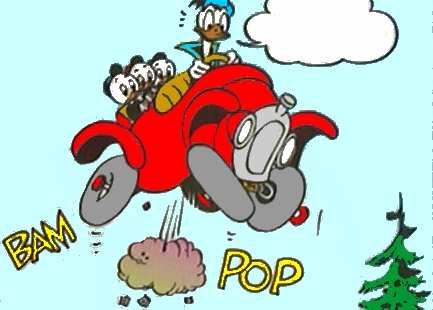David Conwill
Call Me a Cab
- Messages
- 2,856
- Location
- Bennington, VT 05201
It's good to know that there's a motor oil out there endorsed by Donald Duck.

Gasoline too!

It's good to know that there's a motor oil out there endorsed by Donald Duck.


My first car was a Karmann Ghia, a '58, as I recall. A retired racer, but street legal (sorta). No reverse, which presented no insurmountable obstacle to a strapping 16-year-old with strapping contemporaries needing rides.
I think I paid 65 bucks for it. Or was it 35?
^^^^^
I drove the family’s 1955 Chevrolet two-toned Bel Air to
high school.
I can’t even afford to look at one today.

You can own and enjoy an "old car" for a reasonable amount of money if you aren't looking for one that's currently fashionable -- which excludes most boomer-era coupes, two-door sedans, and sports cars. But an ordinary 1940s 4-door sedan in nice condition, that was a better-engineered car when built than just about any of the 1955-65 models, can be found just about anywhere for less than $10,000, and if you stick with a Ford, GM, or Chrysler product parts and service availability are no problem. If you're handy, and you should be if you intend to own any kind of an old car, you can do most of the routine maintenance -- oil changes, greasing, tuneups, routine parts replacements -- yourself.
The most important thing to look for, outside of rust, is the condition of the car's electrical system. You can buy a new wiring harness for $700 or so, and if you intend on driving it for any amount of time, you should. Whether you can put it in yourself or will need to hire it done depends on the complexity of the car, but most pre-1950s cars are much less complex in this respect than later models. In any event, driving an old car with the original wiring is a ticking time bomb -- at best you can expect all kinds of weird, random electrical problems, and at worst you can go up in flames.
Canada, Maine, or Minnesota? The lumberjack figure could be of Paul Bunyan, I guess.
Canada, Maine, or Minnesota? The lumberjack figure could be of Paul Bunyan, I guess.
Many places in Michigan, Wisconsin and Maine claim that as well as far as PB's hometown.Maybe it's Bimidji, Paul Bunyan's hometown. The Valley of the Jolly Green Giant is in Minnesota, too, out New Ulm way. I've been there and to the other Ulm, too.
 John Lofgren Monkey Boots Shinki Horsebuttt - $1,136 The classic monkey boot silhouette in an incredibly rich Shinki russet horse leather.
John Lofgren Monkey Boots Shinki Horsebuttt - $1,136 The classic monkey boot silhouette in an incredibly rich Shinki russet horse leather.  Grant Stone Diesel Boot Dark Olive Chromexcel - $395 Goodyear welted, Horween Chromexcel, classic good looks.
Grant Stone Diesel Boot Dark Olive Chromexcel - $395 Goodyear welted, Horween Chromexcel, classic good looks.  Schott 568 Vandals Jacket - $1,250 The classic Perfecto motorcycle jacket, in a very special limited-edition Schott double rider style.
Schott 568 Vandals Jacket - $1,250 The classic Perfecto motorcycle jacket, in a very special limited-edition Schott double rider style. A fez, if they were trying for that, would taper a bit more toward the top. This looks like a wool watchcap.Many places in Michigan, Wisconsin and Maine claim that as well as far as PB's hometown.
@LizzieMaine - LOL, I don't think they were trying for a fez, but it sure looks like it.


